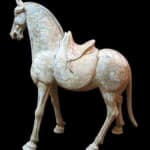Painted Pottery Horse with Detachable Saddle, 618 CE - 700 CE
Terracotta
height 58.4 cm
height 23 in
height 23 in
LA.565
Further images
The most magnificent horses, immortalised in Chinese literature and the visual arts, were the Ferghana horses introduced into China from the west (from modern Uzbekistan, Tajikistan and Kyrgyztan) during the...
The most magnificent horses, immortalised in Chinese literature and the visual arts, were the Ferghana horses introduced into China from the west (from modern Uzbekistan, Tajikistan and Kyrgyztan) during the Han dynasty (206 BC-AD 220). Obtaining these extraordinary stallions was still a priority for the Tang dynasty Emperor Taizong (r. AD 626-49), despite the fact that by the middle of the 7th century the Tang government owned more than 700,000 -built up through tribute gifts and the careful management of official herds. Emperor Taizong was so devoted to his own horses that he ordered bas reliefs of his six favourite battle steeds to be carved and placed at his tomb. Even Emperor Xuanzong (r. AD 847-59) was said to have had two consuming passions - beautiful women and horses, and a dramatic painting of one of his favourite horses, Night-Shining White, by the renowned horse painter Han Gan (AD 720-60) can now be seen now in the Metropolitan Museum of Art.
Such horses were used both for military campaigns and for leisure activities - for the Tang dynasty élite they became symbols of power and prosperity. Furthermore, during the early years of the Tang dynasty, the increasing cross-cultural fertilisation between sedentary Chinese and Central Asian semi-nomadic people encouraged the fashion of horse riding. Its tremendous popularity was very soon restrained by an imperial edict in 667, decreeing that only aristocrats (of both sexes) should be allowed to ride horses: owing a horse then became a privilege that only members of the higher class would have to.
It is then not surprising that during the Tang Dynasty this mania would permeate and greatly influence the mingqi (burial) artistic repertoire. In terms of technical and artistic achievement, as sculptural representations of the fashions of the time, the highest quality painted pottery mingqi tended to be more successful than those glazed. In fact, while sancai objects required greater expenditure of material and labour, the application of the rich glaze meant instead, that the replication of fine details in drapery and physiognomy was generally overseen, while for the unglazed painted pottery the artisans felt best able to explore the details and overall decoration that fascinated the Tang aristocracy.
Our horse perfectly exemplifies the early artistic production of the Central Plains (Henan and Shaanxi provinces) during the 7th century AD, when more detailed sculptures of caparisoned horses were placed in the tombs of the wealthy as companions for the afterlife. This impressive sculpture -its legs, torso, and head individually moulded and then attached together- still retains much of the original white pigment intact. However, even more impressive, is the removable saddle with engraved details that was once painted orange. The horse's ears stand up in caution, its striking eyes well defined, a portion of its mane combed in front of the ears and split into a part. Its nostrils are flared and its mouth is semi-open, suggesting the horse's impatience to depart for a long vigorous journey. These rare features, in particular the open mouth, mane and removable saddle, are highly sought after by collectors.
Such horses were used both for military campaigns and for leisure activities - for the Tang dynasty élite they became symbols of power and prosperity. Furthermore, during the early years of the Tang dynasty, the increasing cross-cultural fertilisation between sedentary Chinese and Central Asian semi-nomadic people encouraged the fashion of horse riding. Its tremendous popularity was very soon restrained by an imperial edict in 667, decreeing that only aristocrats (of both sexes) should be allowed to ride horses: owing a horse then became a privilege that only members of the higher class would have to.
It is then not surprising that during the Tang Dynasty this mania would permeate and greatly influence the mingqi (burial) artistic repertoire. In terms of technical and artistic achievement, as sculptural representations of the fashions of the time, the highest quality painted pottery mingqi tended to be more successful than those glazed. In fact, while sancai objects required greater expenditure of material and labour, the application of the rich glaze meant instead, that the replication of fine details in drapery and physiognomy was generally overseen, while for the unglazed painted pottery the artisans felt best able to explore the details and overall decoration that fascinated the Tang aristocracy.
Our horse perfectly exemplifies the early artistic production of the Central Plains (Henan and Shaanxi provinces) during the 7th century AD, when more detailed sculptures of caparisoned horses were placed in the tombs of the wealthy as companions for the afterlife. This impressive sculpture -its legs, torso, and head individually moulded and then attached together- still retains much of the original white pigment intact. However, even more impressive, is the removable saddle with engraved details that was once painted orange. The horse's ears stand up in caution, its striking eyes well defined, a portion of its mane combed in front of the ears and split into a part. Its nostrils are flared and its mouth is semi-open, suggesting the horse's impatience to depart for a long vigorous journey. These rare features, in particular the open mouth, mane and removable saddle, are highly sought after by collectors.







